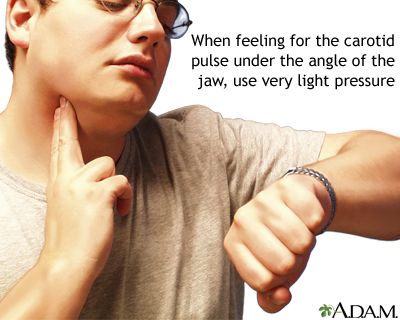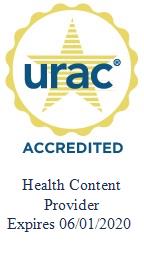Health Library
Pulse - bounding
Bounding pulse
A bounding pulse is a strong throbbing felt over one of the arteries in the body. It is due to a forceful heartbeat.
Images

I Would Like to Learn About:
Causes
A bounding pulse and rapid heart rate both occur in the following conditions or events:
- Abnormal or rapid heart rhythms
- Anemia
- Anxiety
- Long-term (chronic) kidney disease
- Fever
- Heart failure
- Heart valve problem called aortic regurgitation
- Heavy exercise
- Overactive thyroid (hyperthyroidism)
- Pregnancy, because of increased fluid and blood in the body
When to Contact a Medical Professional
Call your health care provider if the intensity or rate of your pulse increases suddenly and does not go away. This is very important when:
- You have other symptoms along with increased pulse, such as chest pain, shortness of breath, feeling faint, or loss of consciousness.
- The change in your pulse does not go away when you rest for a few minutes.
- You already have been diagnosed with a heart problem.
What to Expect at Your Office Visit
Your provider will do a physical exam that includes checking your temperature, pulse, rate of breathing, and blood pressure. Your heart and circulation will also be checked.
Your provider will ask questions such as:
- Is this the first time you have felt a bounding pulse?
- Did it develop suddenly or gradually? Is it always present, or does it come and go?
- Does it only happen along with other symptoms, such as palpitations? What other symptoms do you have?
- Does it get better if you rest?
- Are you pregnant?
- Have you had a fever?
- Have you been very anxious or stressed?
- Do you have other heart problems, such as heart valve disease, high blood pressure, or congestive heart failure?
- Do you have kidney disease?
The following diagnostic tests may be performed:
- Blood studies (CBC or blood count), basic metabolic panel
- Chest x-ray
- ECG (electrocardiogram)
- Echocardiogram
Related Information
PulseArrhythmias
Heart palpitations
References
Fang JC, O'Gara PT. The history and physical examination: an evidence-based approach. In: Zipes DP, Libby P, Bonow RO, Mann DL, Tomaselli GF, Braunwald E, eds. Braunwald's Heart Disease: A Textbook of Cardiovascular Medicine. 11th ed. Philadelphia, PA: Elsevier; 2019:chap 10.
McGrath JL, Bachmann DJ. Vital signs measurement. In: Roberts JR, Custalow CB, Thomsen TW, eds. Roberts and Hedges' Clinical Procedures in Emergency Medicine and Acute Care. 7th ed. Philadelphia, PA: Elsevier; 2019:chap 1.
Mills NL, Japp AG, Robson J. The cardiovascular system. In: Innes JA, Dover AR, Fairhurst K, eds. Macleod's Clinical Examination. 14th ed. Philadelphia, PA: Elsevier; 2018:chap 4.
BACK TO TOPReview Date: 4/10/2022
Reviewed By: David C. Dugdale, III, MD, Professor of Medicine, Division of General Medicine, Department of Medicine, University of Washington School of Medicine, Seattle, WA. Also reviewed by David Zieve, MD, MHA, Medical Director, Brenda Conaway, Editorial Director, and the A.D.A.M. Editorial team.
 | A.D.A.M., Inc. is accredited by URAC, for Health Content Provider (www.urac.org). URAC's accreditation program is an independent audit to verify that A.D.A.M. follows rigorous standards of quality and accountability. A.D.A.M. is among the first to achieve this important distinction for online health information and services. Learn more about A.D.A.M.'s editorial policy, editorial process and privacy policy. A.D.A.M. is also a founding member of Hi-Ethics. This site complies with the HONcode standard for trustworthy health information: verify here. |
The information provided herein should not be used during any medical emergency or for the diagnosis or treatment of any medical condition. A licensed medical professional should be consulted for diagnosis and treatment of any and all medical conditions. Links to other sites are provided for information only -- they do not constitute endorsements of those other sites. © 1997- 2022 A.D.A.M., a business unit of Ebix, Inc. Any duplication or distribution of the information contained herein is strictly prohibited.
